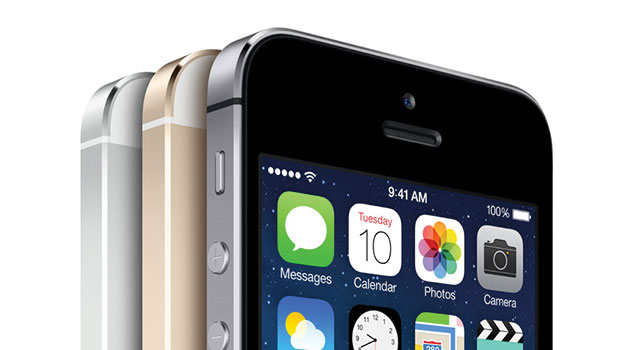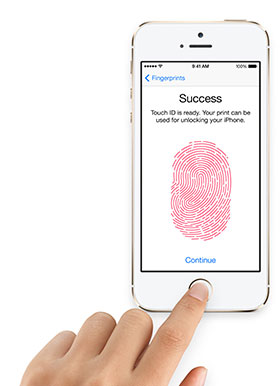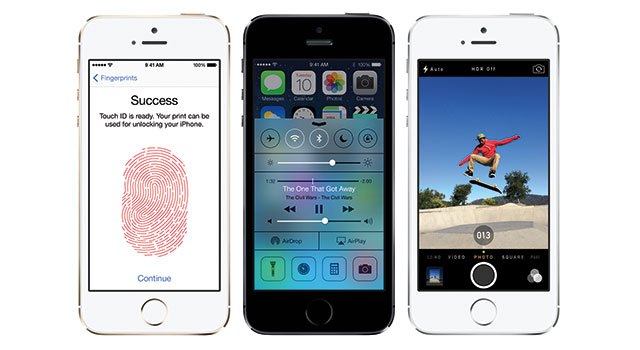
Apple released two iPhone variants this year, the 5s and the 5c. The smartphones were announced in September. According to Apple, it sold a record 9m units in its opening weekend.
The iPhone 5s went on sale in South Africa last Friday. The phone has the same svelte look as the 5, the two models are identical in design, with the same aluminum chassis and 4-inch screen. The only noticeable difference, in fact, is the telling fingerprint sensor on the 5s’s home button, which is also flatter. The volume control, slider switch and power button remain in the same place, while the home button has a stainless steel ring on the edge, used to detect a finger.
The iPhone 5s weighs the same 112g as the 5, with identical dimensions of 123,8mm x 58,6mm x 7,6mm. But the new one comes in a choice of three colours: grey, silver and gold.
The silver and white handset that TechCentral is reviewing seems to be a better colour choice when compared to the black iPhone 5, which displayed scuffs and nicks all over the edges after a year of use. This issue has become a bit of a scandal and even has its own name, “scuffgate”. Apple did away with black on the 5s and replaced it with “space grey”.
The addition of the fingerprint reader, called Touch ID, is used to unlock the phone, which is more convenient than typing a four-digit Pin. It can also be used to authorise purchases on the App Store. It works very well, scanning accurately and quickly most of the time. If, after three attempts, you haven’t been able to sign in or purchase an app, you are prompted to enter a Pin.
Initial set up of Touch ID is straightforward. You simply place your finger on the scanner to enrol your fingerprint. You are allowed to store up to five fingerprints, but having two thumbprints should be sufficient because, the more fingerprints stored, the longer it takes to read. Touch ID reads a fingerprint from any direction, even upside down — perhaps useful after a few too many at your local pub.
After having just reviewed the 5,2-inch LG G2, we found the iPhone’s 4-inch display quite small. It’s still very much in the phone rather than phablet category, but compared to current high-end smartphone rivals, the 5s is dwarfed. It won’t be surprising if the next-generation iPhone screen is 4,5 inches or larger. In fact, the rumour mill suggests Apple may be working on a 4,7-inch model and even a 5,7-inch phablet for 2014.
When using the 5 and 5s side by side, there is a slight but noticeable “warmer” hue on newer model’s screen. At the highest level of screen brightness on both handsets, the 5s is slightly off-white.
 The 5s is powered by Apple’s dual-core A7 processor, the world’s first 64-bit processor on a mobile phone. This doesn’t mean much for now, but could point to an effort by Apple to blur the distinction between its desktop and mobile lines.
The 5s is powered by Apple’s dual-core A7 processor, the world’s first 64-bit processor on a mobile phone. This doesn’t mean much for now, but could point to an effort by Apple to blur the distinction between its desktop and mobile lines.
The 5s also has an M7 motion coprocessor health fanatics will love. It uses very little power and can be used to monitor and track all your movements. An app that works really well with the M7 chip is Nike+ Move, which tracks your movements, displays your Nike “Fuel” points earned, shows your movements in coloured graphs, and allows you to link your Nike+ account and connect with friends. It cuts out the need to wear any additional gadget to track your fitness.
Not surprisingly, the 5s is snappier than the iPhone 5 when it comes to launching apps, browsing the Web or watching videos. However, on a couple of occasions, our review unit randomly crashed — with the screen going blank and the device rebooting. The new Tweetbot app crashed the phone a few times on the 5s, whereas it continued working fine on the 5. According to Crittercism, a mobile application performance management specialist, apps crash twice as often on the 5s than the 5c due to the 64-bit chip on the former. It’s apparently happening because developers are not optimising their apps for the hardware on the 5s. It is rather frustrating.
The camera on the 5s is an 8-megapixel affair, as in the iPhone 5, but the newer model has a larger lens. This means more light can reach the sensor, offering better quality pictures in low-light conditions. It also has auto (not optical) image stabilisation, and a dual-LED flash — white and amber — to achieve more natural-looking light and colour in photos.
Two nifty new features in the camera app are “burst mode” and “slo-mo” video. Burst mode is amazing, it takes up to 10 frames per second so you don’t miss the best shot from an action sequence. It only works on the normal photo ad square photo shooting modes. You simply press and hold the shutter release button for a series of rapid shots. A count of how many shots you’ve taken appears next to the shutter button.
Slo-mo video recording shoots in 120fps and, apart from testing the mode, we haven’t really found a use for it. When you record in slo-mo mode, Apple automatically selects which part of the video to turn into slow motion, but you can use the edit tool to adjust this. However, sharing the slo-mo video does get a bit tricky — they won’t display on Instagram and the like.
Video mode supports full 1080p HD recording at 30fps with a 3x zoom. The front-facing, 1,2-megapixel camera is capable of 720p, which is fine for Skype or FaceTime.
Battery life on the 5s has been improved slightly — it has been bumped up to 1 540mAh from the 1 440mAh on the iPhone 5. If you’re out and about most of the day, chances are you will need to find a plug, but on a regular day, even with the M7 coprocessor running in the background, it should take you into the evening.

If you’re using the iPhone 5 and are considering the 5s as an upgrade, you won’t feel like you’ve really got a major new release. Yes, Touch ID is quite impressive and the camera is fantastic, but it is really intended as an upgrade to the 4S — in which case, you’re getting a bigger screen and a much lighter and speedier handset.
Pricing on the iPhone 5s starts at R9 999 for the 16GB model, while the 32GB and 64GB versions will cost R11 499 and R12 999 respectively at the iStore. Vodacom is offering the 16GB model for R10 499 and the 32GB and 64GB versions will set you back R11 799 and R13 299 respectively.
Also launched in South Africa last week was the iPhone 5c, which is meant to be a “low cost” device. However, South African pricing makes it difficult to justify. The 16GB entry level model costs a whopping R8 499. Essentially, the iPhone 5c is the iPhone 5, but with a colourful, Nokia Lumia-esque plastic exterior. They have similar specifications — both run on the same A6 processor, sport 4-inch “Retina” displays, with the same 8-megapixel rear-facing camera.
Unless they absolutely always have to have Apple’s latest and greatest, iPhone 5 users are better off waiting for the next-generation iPhone that will inevitably come next year. 4S users who are committed to the Apple platform — or just locked into the ecosystem — won’t regret the upgrade. — (c) 2013 NewsCentral Media




